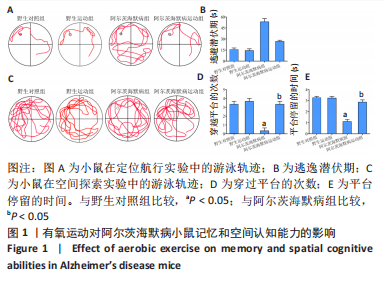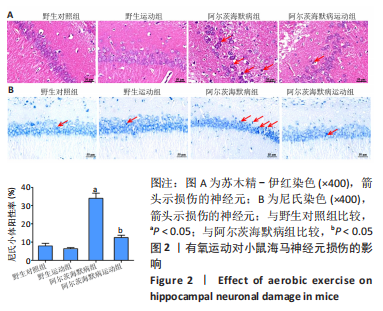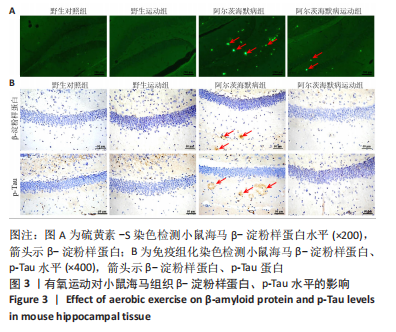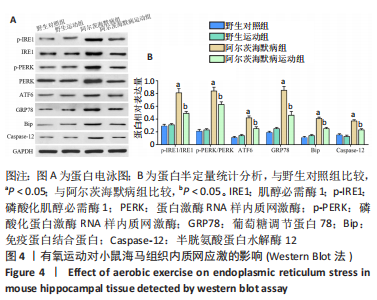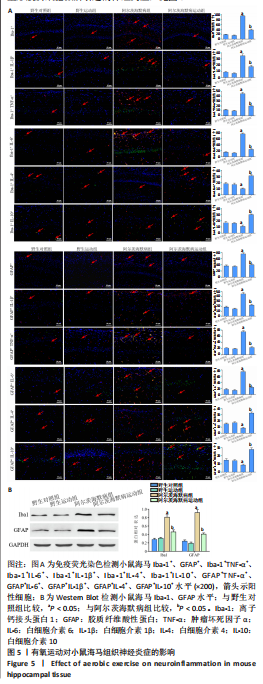中国组织工程研究 ›› 2024, Vol. 28 ›› Issue (14): 2209-2214.doi: 10.12307/2024.307
• 组织构建细胞学实验 cytology experiments in tissue construction • 上一篇 下一篇
有氧运动抑制神经炎症减轻阿尔茨海默病模型小鼠认知障碍
邓龙飞1,张业廷2,付 燕1
- 1西南民族大学,四川省成都市 610225;2中国民用航空飞行学院,四川省广汉市 618307
Aerobic exercise inhibits neuroinflammation and alleviates cognitive impairment in Alzheimer’s disease model mice
Deng Longfei1, Zhang Yeting2, Fu Yan1
- 1Southwest University for Nationalities, Chengdu 610225, Sichuan Province, China; 2Civil Aviation Flight University of China, Guanghan 618307, Sichuan Province, China
摘要:
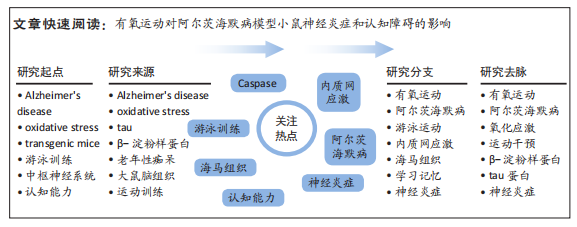
文题释义:
阿尔茨海默病:是一种好发生于老年人群中的神经退行性疾病,患者主要表现为认知和记忆功能障碍。阿尔茨海默病的主要病理特征为β-淀粉样蛋白异常沉积形成老年斑、Tau蛋白过度磷酸化形成神经原纤维缠结、突触丢失、神经元死亡和神经炎症等。有氧运动:是一种运动强度低且持续时间长、并能提高机体抗氧化能力和全身耐力的运动方式,有氧运动通过改善脑组织血液循环、提高海马可塑性,缓解内质网应激,改善阿尔茨海默病患者认知功能,提高其生活自理能力,是一种替代药物干预的有效手段。
背景:阿尔茨海默病患者主要表现为认知和记忆功能障碍,有氧运动能够抑制内质网应激,改善阿尔茨海默病患者认知功能,然而有氧运动是否抑制内质网应激依赖的神经炎症尚不清楚。
目的:探究有氧运动对阿尔茨海默病模型小鼠神经炎症和认知障碍的影响。方法:C57BL/6J野生型雄性小鼠50只随机分为野生对照组、野生运动组;APP/PS1双转基因雄性小鼠50只随机分为阿尔茨海默病组和阿尔茨海默病运动组,每组各25只。野生运动组、阿尔茨海默病运动组小鼠进行有氧运动训练(跑台运动,45 min/d,速度为12 m/min,5 d/周,共8周);将野生对照组、阿尔茨海默病组小鼠放置在安静跑台上。Morris水迷宫实验检测小鼠认知能力;硫黄素-S染色检测海马组织β-淀粉样蛋白含量;苏木精-伊红染色和尼氏染色检测小鼠海马组织损伤情况;免疫组化染色检测海马组织β-淀粉样蛋白、p-Tau水平;免疫荧光染色检测海马组织神经炎症相关因子阳性细胞数;Western Blot检测海马组织内质网应激相关蛋白p-IRE1、IRE1、p-PERK、PERK、ATF6、GRP78、Bip、Caspase-12、Iba-1、GFAP的水平。
结果与结论:①与野生对照组相比,阿尔茨海默病组小鼠逃避潜伏期增加、到达先前平台的次数和在平台停留的时间减少,海马组织β-淀粉样蛋白、Tau水平和内质网应激相关蛋白p-IRE1/IRE1、p-PERK/PERK、ATF6、GRP78、Bip、Caspase-12、Iba-1、GFAP水平升高,神经炎症相关因子Iba-1+、Iba-1+TNF-α+、Iba-1+IL-6+、Iba-1+IL-1β+、GFAP+、GFAP+TNF-α+、GFAP+IL-6+、GFAP+IL-1β+阳性细胞数增加,Iba-1+IL-4+、Iba-1+IL-10+、GFAP+IL-4+、GFAP+IL-10+阳性细胞数减少(P < 0.05);与阿尔茨海默病组相比,阿尔茨海默病运动组小鼠逃避潜伏期减少、到达先前平台的次数和在平台停留的时间增加,海马组织β-淀粉样蛋白、Tau水平和内质网应激相关蛋白水平及炎症相关因子阳性细胞数呈现相反的变化(P < 0.05)。②结果说明,有氧运动能够抑制海马组织内质网应激依赖的神经炎症,减轻阿尔茨海默病小鼠认知障碍。
https://orcid.org/0009-0000-0200-6498(邓龙飞)
中国组织工程研究杂志出版内容重点:组织构建;骨细胞;软骨细胞;细胞培养;成纤维细胞;血管内皮细胞;骨质疏松;组织工程
中图分类号:
